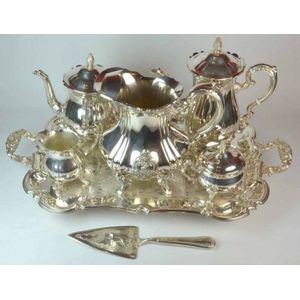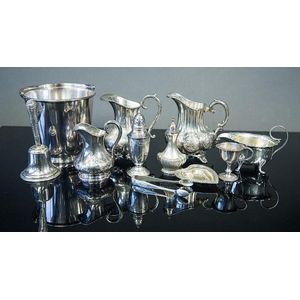Norwegian Sterling Silver Viking Ship Cruet Set
You must be a subscriber, and be logged in to view price and dealer details.
Subscribe Now to view actual auction price for this item
When you subscribe, you have the option of setting the currency in which to display prices to $Au, $US, $NZ or Stg.
- Sterling Silver - Sterling silver is a mixture of 92.5% pure silver and 7.5% of another metal, usually copper. Fine silver is 99.9% pure silver, and is relatively soft and the addition of the very small amount of copper gives the metal enough strength and hardness to be worked into jewellery, decorative and household objects.
- Pineapple - The pineapple, named because of its resemblance to a pine cone, was an exotic and scarce fruit in the 18th century. It became a popular decorative motif on furniture, silver ceramics, glass and clocks during this time.
- Cornucopia - The cornucopia, literally the horn of plenty, is a symbol of abundance and wealth. It is traditionally is represented by a curved goat horn overflowing with grain and fruit.
Modern cornucopias are often depicted as horn-shaped baskets filled with food, and this symbol is often associated with the harvest. This decorative device has a long and ancient history, with roots in Greek mythology.
In one version, when Zeus was playing with the goat Amalthea he accidentally broke off one of her horns. To atone for this, Zeus promised Amalthea that the horn would always be full of whatever fruits she desired. This became the cornucopia of the Roman goddess Copia, the personification of plenty. Other goddesses, including Fortuna and Pax, also held the cornucopia.
In furniture and decorative arts, cornucopia as a decorative element have been popular since the 16th century and can be found on items as diverse as light fittings and candelabra to clocks, sculpture and statuary and furniture.
In ceramics, cornucopia shaped vases were popular in the 19th century, in singles and pairs.
This item has been included into following indexes:
Visually similar items

A three piece sterling silver cruet, and condiment spoon, mid 1920s Birmingham, with maker's mark for William Suckling Ltd, the cruet set of traditional style with a cauldron salt and mustard pot with curvaceous feet and blue glass liners, a pear shaped sh

Sterling silver cruets, silver spoons, pepper, salts, mustard, etc Hallmarked Adie Bros. c.1932 (11). 241g approx

A silver plated tea & coffee service with tray, mid 20th century, comprising of teapot, coffeepot, water jug, cream jug, sugar bowl, cake server and butlers tray, manufactured USA

11 various silverplated table items, including ice bucket; three various EPBM cream jugs; bell; & sauce jug etc.
